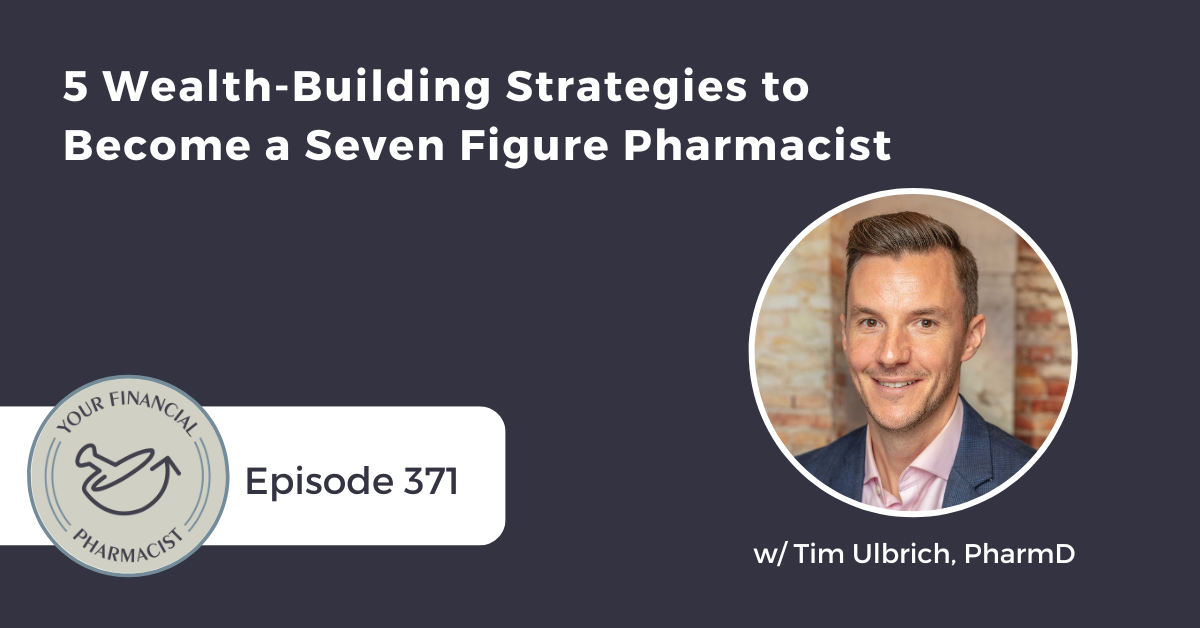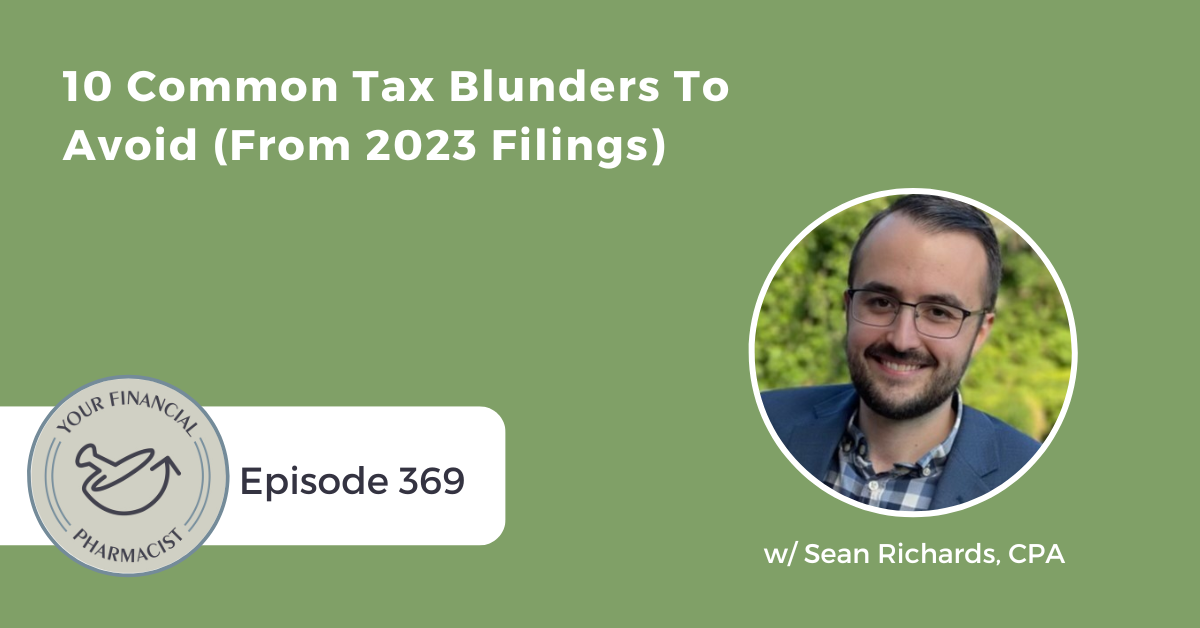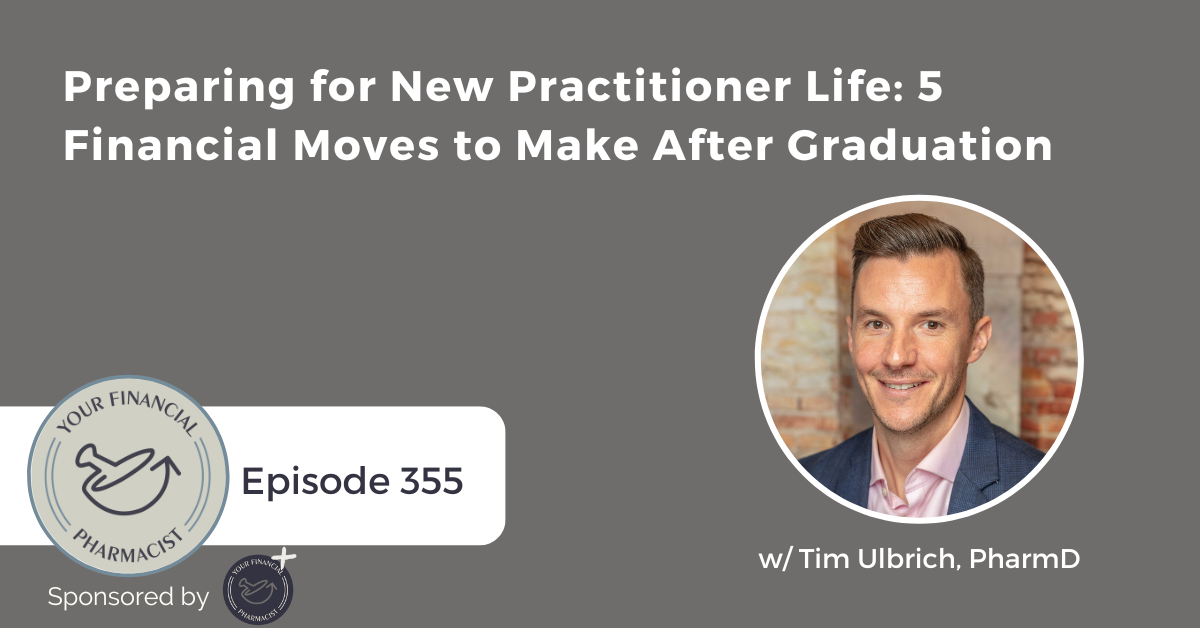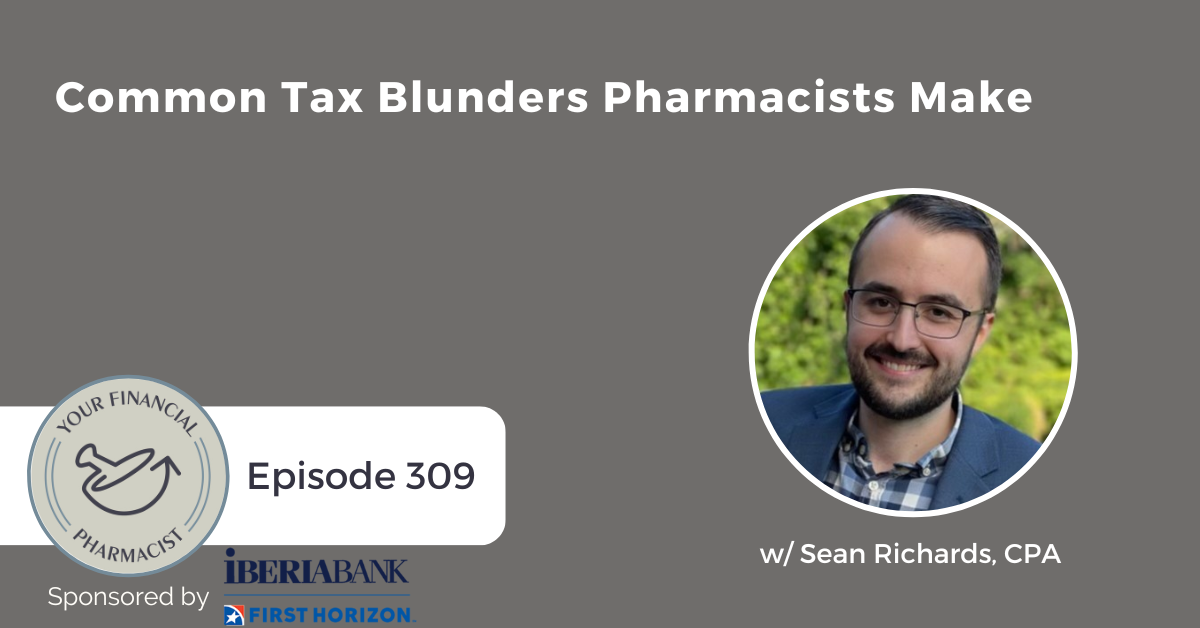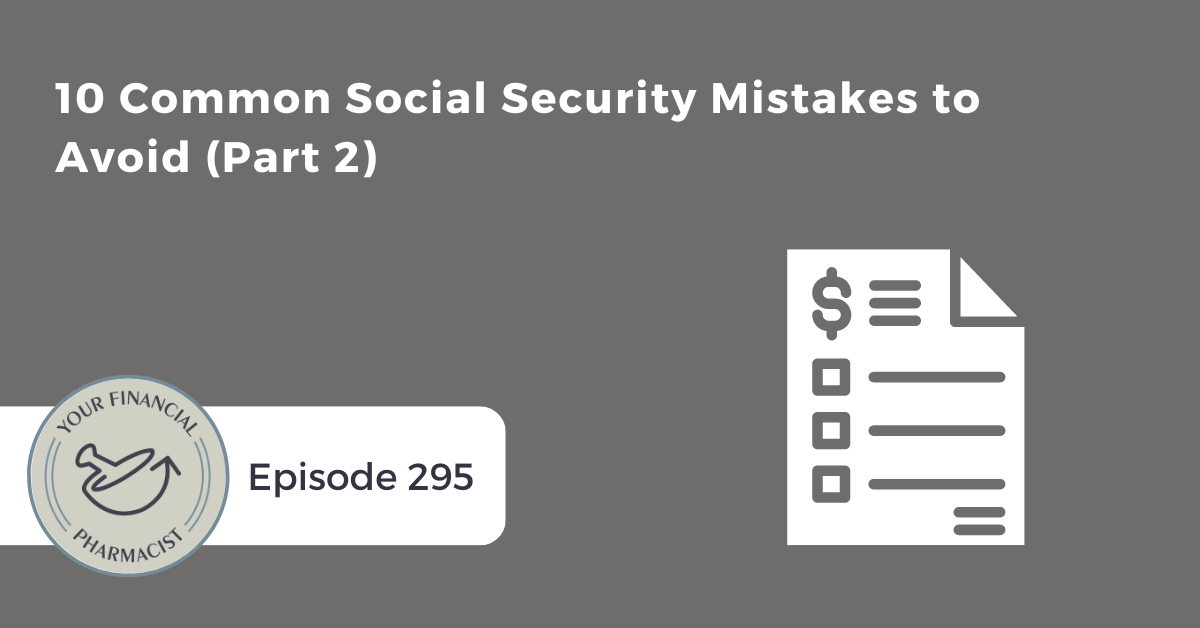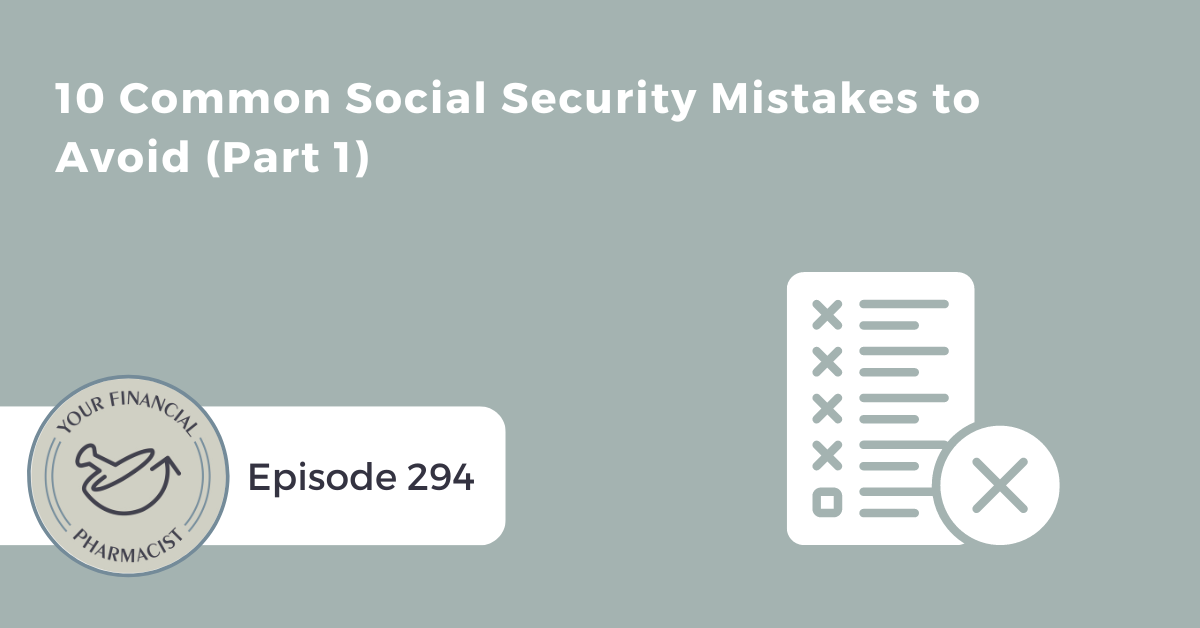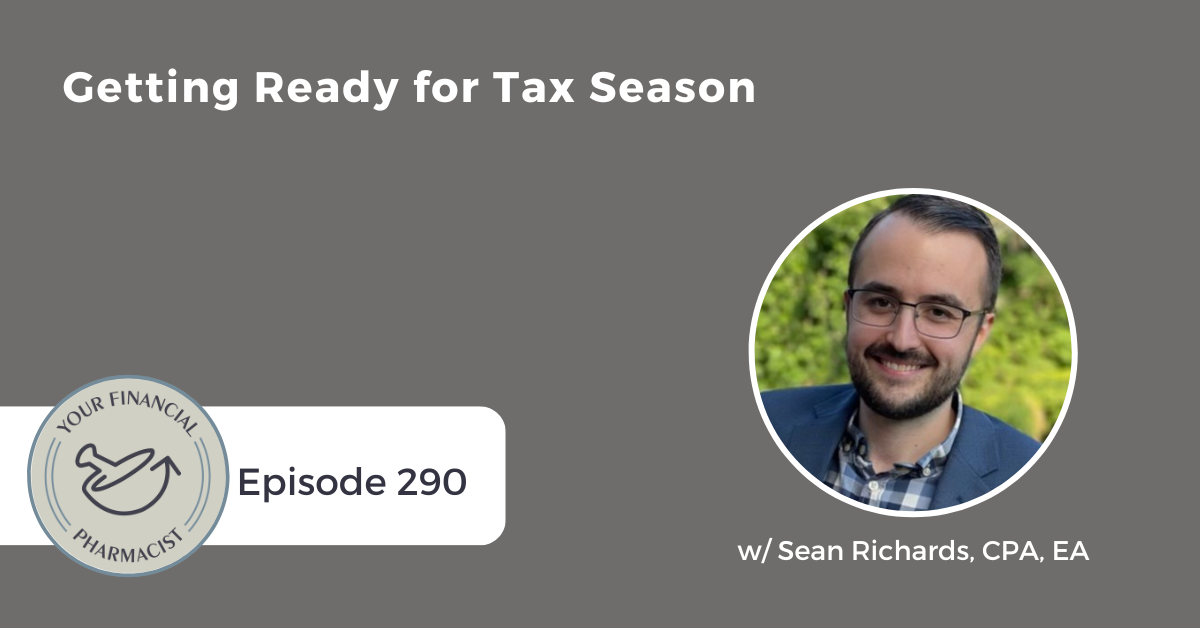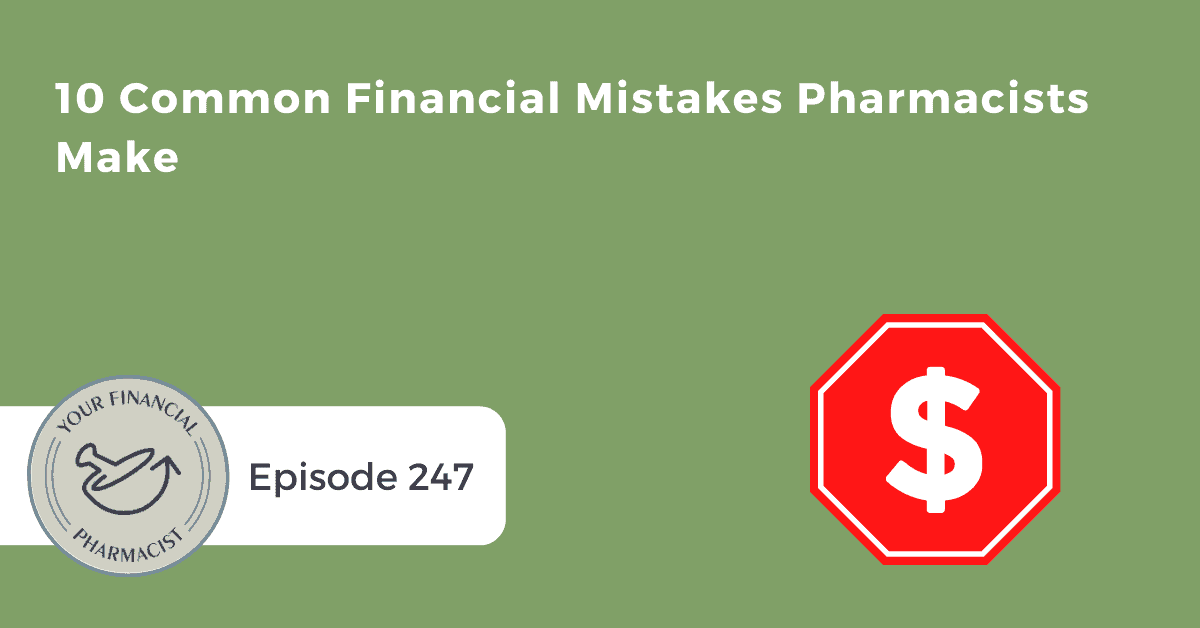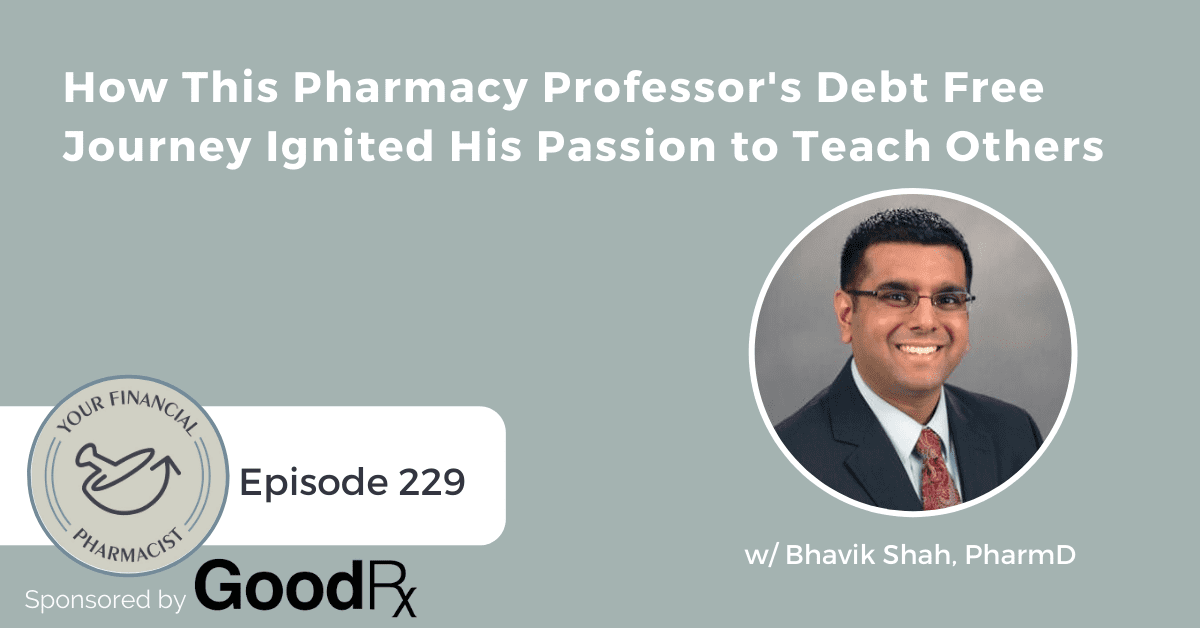Tim Ulbrich, YFP Co-Founder and CEO shares five wealth-building strategies to include in your own financial plan.
Episode Summary
In this episode, Tim Ulbrich, YFP Co-Founder and CEO, shares five wealth-building strategies you can incorporate into your own financial plan. Drawing from his own financial journey, these strategies have been tested, refined, and used by Tim and his wife, Jess.
From setting savings goals to tracking net worth monthly to increasing your financial IQ, Tim makes setting up your financial path for success more attainable.
About Today’s Guest
Tim Ulbrich is the Co-Founder and CEO of Your Financial Pharmacist. Founded in 2015, YFP is a fee-only financial planning firm and connects with the YFP community of 15,000+ pharmacy professionals via the Your Financial Pharmacist Podcast podcast, blog, website resources and speaking engagements. To date, YFP has partnered with 75+ organizations to provide personal finance education.
Tim received his Doctor of Pharmacy degree from Ohio Northern University and completed postgraduate residency training at The Ohio State University. He spent 9 years on faculty at Northeast Ohio Medical University prior to joining Ohio State University College of Pharmacy in 2019 as Clinical Professor and Director of the Master’s in Health-System Pharmacy Administration Program.
Tim is the host of the Your Financial Pharmacist Podcast which has more than 1 million downloads. Tim is also the co-author of Seven Figure Pharmacist: How to Maximize Your Income, Eliminate Debt and Create Wealth. Tim has presented to over 200 pharmacy associations, colleges, and groups on various personal finance topics including debt management, investing, retirement planning, and financial well-being.
Key Points from the Episode
- Wealth-building strategies for pharmacists with student loan debt. [0:00]
- Financial struggles and debt repayment for pharmacists. [3:21]
- Financial planning for pharmacists, focusing on strategies for success. [8:28]
- Tracking net worth and setting savings buckets for financial goals. [12:33]
- Financial planning, saving, and investing for pharmacists. [17:41]
- Wealth-building strategies and financial planning. [22:33]
Episode Highlights
“And I had realized that despite the amazing opportunities that graduating with a pharmacy degree had offered, there was a little discussed truth among practitioners in the field. And that is that most pharmacists make a good income, but have significant student loan debt and feel like, hey, there should be more here; I shouldn’t feel as stressed and overwhelmed as I do with my financial situation.” – Tim Ulbrich [2:52]
“But it takes a lot of intention, time and effort to translate that income, to making sure that we’re actually progressing in our financial plan and finding the ever so important balance between saving for the future while also living a rich life today and investing in those things that are most meaningful to us.” – Tim Ulbrich [6:46]
“We learned a very important lesson that there is no such thing as arrived. When it comes to the financial plan, there is always an opportunity to grow and learn.” – Tim Ulbrich [7:25]
“These strategies are not overly complicated. It doesn’t have to include fancy spreadsheets and nuanced investment vehicles. It doesn’t take an exorbitant amount of time. And it doesn’t mean that you have to live on rice and beans. I did it and you can do it too.” – Tim Ulbrich [9:36]
“I want you to take a step back and ask yourself a few questions. What am I trying to accomplish? What’s the purpose? What does success look like? After all, money is a tool for living a rich life. And it’s up to you to decide what that rich life looks like.” – Tim Ulbrich [12:04]
“Resist the urge to try to do too much. And eventually getting to a place of frustration where you don’t make much progress at all. What is the one next move that you can make? This is a marathon, not a sprint, one step after another over a long period of time will yield big results.” – Tim Ulbrich [25:44]
Links Mentioned in Today’s Episode
- Toolbox: https://yourfinancialpharmacist.com/toolbox
- YFP Planning
- The Millionaire Next Door by Tom Stanley
- YFP Compound Interest Calculator
- YFP Podcast Episode 351: Legacy Planning 101: How to Build Your Legacy Folder and Why It’s Important
- The Compound Effect by Darren Hardy
- YFP Disclaimer
- Subscribe to the YFP Newsletter
- Tim Ulbrich on LinkedIn
- YFP on Instagram
- YFP Facebook Group
Episode Transcript
Tim Ulbrich 00:00
Hey guys, welcome to this week’s episode of the YFP Podcast. I gotta admit, I’m pumped up for this one, I’m going to be talking through five wealth building strategies that you should employ in your own financial plan. No theory, no textbook stuff here. These are all strategies, all five of them, that Jess and I have tested, refined and used in our own financial plan. Now, before I get into these five wealth building strategies, I have two goals for this episode that I want to share with you. First, my hope and desire is to motivate and inspire you to take action. It is so easy to become overwhelmed, and fall into that paralysis analysis when it comes to the financial plan. So for those of you that are listening, that are feeling overwhelmed, or anxious, or frustrated, maybe stuck, or just this lingering, nagging feeling that there’s something more that could be done, I want to be a source of inspiration through sharing my own journey, and encouraging you on your journey as well. Now, that doesn’t mean it’s going to be easy. That doesn’t mean that you’re not going to have some mistakes and roadblocks along the way, there certainly will be. My second goal is to give you specific strategies that you can implement, starting today in your own plan; to take the motivation and to then take action that can yield results as you take steps in applying this to your own situation.
Tim Ulbrich 01:25
Okay, let’s jump in. I’m going to start with my own story that really begins back in 2009. 2009. So at this point in time, I had just finished my PGY one residency, I was making a whopping $31,000. At the time, thankfully, residents make a little bit more these days. And I finally had reached the other side, right? Ready to cash in on the mystical, six figure pharmacist income that I often thought about during pharmacy school. Now, everything was looking good. Until I realized that I overlooked one very important minor detail. And that was that I was broke. No not broke, broke, but definitely high earner high income broke. My wife Jess and I were in spectacular shape on the surface. But underneath our lifestyle and this new six figure income, really our finances underneath that had a different story, we had over $200,000 of student loan debt that was almost all my student loan debt. Actually, the vast majority of that $185,000 or so was my student loan debt. We had a house at this point with almost no equity. We had very little in savings. And we soon had a growing family to support today we’ve got four boys, our oldest was born in 2011. So there was a lot of things that were going on and happening financially, perhaps some of you can relate to that. And I had realized that despite the amazing opportunities that graduating with the pharmacy degree had offered, there was a little discussed truth among practitioners in the field. And that is that most pharmacists make a good income, but find themselves in exactly the same boat that I’m describing, right. Earning a good income, significant student loan debt and feeling like, hey, there should be more here, they shouldn’t feel as stressed and overwhelmed as I do with my financial situation. Now, as I reflect on that journey, I am certainly grateful for the experiences I’ve had, and for what I have learned along the way. I also feel though, the fear and anxiety coming up when acknowledging that my perception of the six figure income and the reality of what it could be, were two very different things. Now it took me four humbling years, hopefully it won’t take you as long but it took me four humbling years to realize that this six figure income wasn’t all that it was cracked up to be. Now one book in particular, if you’ve listened to the podcast before, you’ve heard me talk about this book, but one book at this point in time 2012, 2013 hit me at the perfect moment. It was a wake up call that I needed. And that book was The Millionaire Next Door by Dr. Tom Stanley. We’ll link to that in the show notes. And that book taught me a very important lesson. And that lesson being that net worth, not income, net worth is a much better indicator of your financial health. Now more to come on this here and a little bit but understand for the time being that net worth is your assets what you own, minus your liabilities what you owe, and it paints a nice picture of what did or didn’t happen with your income, right, that’s earned. And after reading this book, I decided that it was time to put pen to paper and do our own calculation. Now when I did this, the assets column, right, on the left hand side of the paper, I had the liabilities on the right hand side of the paper and the left side was pretty blank. Didn’t have a whole lot of assets at that point a little bit in a 401K,little bit in an IRA, we had some value in the home that that was offset by the liability. But the right side the liabilities, what we owed, there was a laundry list of things that are highlighted by none other than that couple $100,000 of student loan debt that I mentioned, most of which was at a fixed interest rate of 6.8%. A number I will never forget. I know many of you are perhaps facing a similar situation. Now this calculation, this net worth calculation at the time, showed that just four years after graduating from pharmacy school, finishing up my residency, had earned about a half a million dollars of income. But I had a net worth, again, assets minus liabilities of negative $225,000. Ouch, right? Ouch. I was overwhelmed with student loan debt. I was confused about how to best save and invest for the future, I was frustrated by the fact that, hey, we’re making a good income. But we’re not progressing financially as quickly as we should be, or at least as I thought we should be. So if you are like most pharmacists that I talked with, perhaps your journey may include something similar. You might even be there right now, some of you have gone down this journey before or perhaps for students listening. It’s something that you’re thinking about in the future. And, you know, as I think about this, it wouldn’t be so frustrating if you didn’t do everything that perhaps you were told was the right quote, “right thing to do.” Right, you got the degree, you landed the high paying job, you started making some of those smart decisions, some of you have already purchased a home, you’ve been investing, maybe you got that reliable car, and you’re finally reaping the benefits of all that hard work. But it takes a lot more intention, time and effort to translate that income, to making sure that we’re actually progressing in our financial plan and finding the ever so important balance between saving for the future, taking care of our future selves, living a rich life today and investing in those things that are most meaningful to us.
Now, thankfully, for our story, there’s a happy ending. Three years after that point where we realize, hey, we’re making a good income, but the net worth is negative, it’s not showing, we decided through that time period to really get serious, to stop messing around, to take control of our financial future. And in the fall of 2015, we hit submit on the very last payment of that $200,000 of student loan debt. I still have the screenshot saved at the time. Navient was the loan servicer, it’s an image I’ll never forget. Now to get there. We had to sever self teach ourselves personal finance. This was what led to me starting the Your Financial Pharmacist Community shortly thereafter, in 2015. And we made several mistakes along the way. And I’m going to talk about some of those here in just a little bit. Now, at the time, no one in our sphere no one in our community is really talking about this. And it was hard. It was hard, but it was worth it. Now, a little bit more on this story, when we hit submit on that last student loan payment is the fall of 2015, it sure felt like we had arrived financially finally, right? That would be the first however, of many times that we would learn a very important lesson that there is no such thing as arrived. When it comes to the financial plan, there is always an opportunity to grow and learn. Once we had crossed the line from a negative net worth to zero, and eventually working towards positive, it was go time it was time to play offense. Right. Finally, we could begin to play offense with a financial plan. And through methodical savings, investing, diligent spending, planning, and working our butt off building a business, we would eventually cross a net worth of $1 million in 2020. That’s right, negative 225,000 in 2012, to a net worth north of 1 million and approximately eight years. And I want pharmacists like yourself to be fully armed and empowered with the knowledge and tools needed, again, to find that balance between living a rich life today. And tomorrow, you can get there. But in addition to your income, it’s going to require that you have the right mindset, some strategy, and you have habits and behaviors in place that will help you to achieve success, it can be done. And that’s why I’m excited to share some of these strategies with you. It’s not complicated or overly complicated. It doesn’t have to include fancy spreadsheets and nuance investment vehicles. It doesn’t take an exorbitant amount of time. And it doesn’t mean that you have to live on rice and beans. I did it and you can do it too.
Tim Ulbrich 09:56
I recently had the chance to talk with a group of pharmacists and I asked them to reflect on a question that was intended to help them clarify what matters most to them in their lives and how their financial plan can support those different areas. And here are just a few of the responses that I received. From that group of pharmacists, quote, “I would love to travel the world give generously, and fund my kids hopes.” Another was, “to take my kids to see the world.” Another, “to have a home in space and time to host family and friends often.” Another, “to volunteer locally, spend time with family and learn new skills.” Another, “To open my new business.” “Working part time without the fear of finances would allow me to volunteer more and do something more passionate about.” Another: “To create a community center for people who use drugs to help provide basic social needs and treatment.” Yes, yes. And yes. Notice what you don’t hear here. You don’t hear people talking about having a pristine, zero based budget. Yes, I think that’s important to help us execute, but that’s not what people are talking about. You don’t hear people talking about having a certain amount of money in the bank. You don’t hear people talking about having a complicated time intensive investment strategy. You don’t hear people talking about their 4.6% high yield savings account and how advantageous that is over another one that’s only 4%. You don’t hear any comments about how to optimize public service loan forgiveness or other student loan strategies. And while there’s nothing wrong with those things, right, I myself like a good budget, like a good student loan repayment strategy, things we talked about often in the show, it’s important to remember that these things aren’t the end goals and determinants of success, but rather steps that are along the way to support again, living that rich life today and tomorrow. So before I get into these five strategies, and before you go all Type A pharmacist on me and start making moves, hitting and checking things off that list, I want you to take a step back and ask yourself a few questions. What am I trying to accomplish? What’s the purpose? What does success look like? Right? After all, money is a tool for living a rich life. And it’s up to you to decide what that rich life looks like. Okay, so let’s jump into these five wealth building strategies, it’s time to take action. Again, none of that fluffy and practical stuff. I’ve implemented all of these in my financial plan. Step number one, you probably saw it was coming based on my discussion of net worth. Step number one is you have to be tracking your net worth. As I mentioned, and that book, The Millionaire Next Door, one of the quotes from that book from the author Tom Stanley is, quote, “one of the reasons that millionaires are economically successful is that they think differently.” And what he’s referring to is that those who build wealth realize that income is not the metric of success, but rather a tool for building wealth, right, and it’s worth repeating the calculation we talked about before, net worth what you own, minus what you owe, so your assets minus your liability. Net worth not income. But net worth is the true indicator of your financial health. And if you understand and respect this calculation, it will propel your financial plan. Discovering net worth was a mindset shift and a pivot point in our own financial planning journey. Now for Jess and I, we update a net worth tracking sheet once per month, which allows us to take a step back and see the overall trajectory and bigger picture, while also focusing on the short term goals. And I have this tracking sheet along with several other resources. I’ll reference throughout the podcast available in a Google Drive, a toolbox. We’ll link to that in the show notes. You can go to that toolbox to access those for free, you can make a copy, edit, customize, make it your own, and be able to implement it in your own financial situation. It’s a very simple spreadsheet. Again, nothing fancy, right, we have a list of all of our assets, all of our liabilities. So this includes things like our emergency funds, various business accounts, kids 529 accounts, all our retirement accounts, different real estate that we own, and so forth. All assets, all liabilities, once a month. This is the big view picture of are we tracking, are we trending in the right direction. So that’s wealth building strategy number one.
Number two, you’ve heard me talk about this on the show before is setting up savings buckets. I love savings buckets. All about intentionality. Once Jess and I are on the same page with our financial goals for a given year, it’s then time to write them down and prioritize them accordingly so that we can start to implement a plan to achieve them, right? Otherwise, it’s a hope, a wish or a dream. So for each goal that we have for the year, we defined several things. First, the amount that is needed to achieve that goal. So for example, if we were to say, hey, we want to refinish the basement, it’s a goal we’re working on here in 2024, we got to put a budget to that we gotta put a number to it. And we got to put eventually a timeline to it. So first, we have to have an amount needed to achieve the goal. Second, is we have to identify the current amount we have saved towards a goal, sometimes that’s a zero. Sometimes that might be a portion of the goal. The third thing is then the gap between the amount needed and the amount saved. Right? This is common sense stuff. And the fourth thing is the monthly contribution needed to close the gap. That’s the key. So we have to know where we’re going, how much do we need? When do we need it? What do we already have saved? What’s the gap? What’s the timeline difference and a monthly contribution that’s going to help us get there because then we can implement that, right, we can do something with that, to be able to put ourselves on track to achieve it. Now, I mentioned the tool box before, there’s another resource in there. I have our savings buckets spreadsheet that you can again, nothing complicated, you can download it, you’ll see it’s just a sheet that outlines different priorities, what the status is, what the goal is, what’s the current funding? What’s the amount, what’s the gap, and what’s the contribution needed to get there with some notes for each of those items as well. So once we have this from here, once we have a prioritized list of our goals, we can then work the budget, or the spending plan, whatever you want to call it to determine how much is available each month to allocate towards the goals and make any necessary adjustments. Now just to give you some context of things that we’re thinking about here, right, this would be items like home improvements, saving and retirement accounts, putting money away into an HSA saving for vacations, saving for a future car purchase, right? These are the types of goals and things that we’re working on. And once we have this prioritized list, and we can begin to weave it into the monthly spending plan, based on hey, we know what you’re gonna make, we know the fixed expenses, the discretionary expenses, we know what’s leftover, then we can allocate whatever is projected to be left over towards the goals we’ve already defined in advance. And this is where the buckets come in. Because once we do this work, we can set up savings buckets. Now we use Ally Online Bank, this is not commercial for Ally, you can do this with many other banks, or you can track it on your own, to have a bucket for each goal. Except for those things that go directly to outside accounts. Right. So I don’t want things like IRA savings, HSAs, 529s to be sitting around in a high yield savings account. But I want those to go to work as quickly as possible for us. But for everything else, right. I mentioned several of these: vacation, home improvement projects, saving for educational expenses, not for future like 529. But for us, that would be homeschool expenses and things that we know are coming throughout the year could be gifts, insurance payments. I said vacations, vehicles, etc. emergency fund savings, right. So when I log on to our Ally online savings accounts, I see all these buckets, which are really just virtual buckets within a high yield savings account that we can then identify and earmark. It’s so important that if we think we’re saving for something, let’s actually do the accounting for it and create the bucket that allows us to see the progress made. This can sound complicated, don’t let it fool you. It’s not complicated. This system took us about 15 to 20 minutes set up. Once we had already done the work right, which is the hard work is talking about the goals and prioritizing the goals. So that’s number two, setting up the bucket system.
Tim Ulbrich 18:51
Number three in our list of five wealth building strategies, is creating a legacy folder again, something I have talked about in the podcast before. And while a legacy folder isn’t going to directly move the needle on your net worth, don’t underestimate what it can offer in terms of peace of mind. And knowing that in the event in an emergency, all your financial documents are organized and in one location. So think of the legacy folder as a one stop shop where you have all of your important financial information, records and systems such that if someone else had access, needed access in the event of emergency, something happened to you, they could quickly pick up where you left off. So our legacy folder is a combination of a shared Google Drive folder, and a fireproof safe at home. Right. So I think about things like passports, birth certificates, etc. copy of estate planning documents, those are going to be inside of a safe, and then we’ve got other things that are on a shared Google Drive. So our financial planning team at YFP has shared access to the Google Drive as well as family who would be caring for our boys in the event that something happened to us, and then we use One Password as a tool to share and store all of our passwords. You can access again in the toolbox resource I mentioned already, we’ll link to that show notes: YourFinancialPharmacist.com/toolbox, I have a legacy folder table of contents that we use that you can download, make a copy, modify and make it your own.
Tim Ulbrich 20:25
Alright, number four on our list of five, upping your financial IQ. So here are just some of the questions I’ve received recently, from pharmacists in our community: how much should I save for retirement? How can I best save and invest for the future? What should my asset allocation be? Do I need a life or disability insurance policy? How can I optimize student loan or other debt payments? Should I save and invest or pay down debt instead? If any of these sound familiar, this is real life stuff. And know that you aren’t alone if several of these questions are swirling around in your mind as well. And as I reflect on my own journey, I realized that knowledge, along with community and accountability, was a key missing ingredient early on. You know, despite being a personal finance nerd today, my financial IQ early in my pharmacy career was very limited. When I was just finishing up my pharmacy school training in 2008, residency 2009. At the time, I could not tell you the difference between a 401K and an IRA a stock versus a bond secured versus unsecured debt, unsubsidized versus subsidized loans, a tax credit versus a deduction, right, the list goes on and on. And my ignorance, my lack of financial IQ led to mistakes and really led to a delay in our progress. But that really wasn’t my fault as I reflect on the journey. Now, taking responsibility of that and learning those things. Certainly, there’s an opportunity there. But know that for many of us, we just don’t have that background. Right, that strong fine foundation and financial literacy, our K-12 system, to be frank does an atrocious job of prioritizing financial literacy. And while I’m grateful for my AP Calculus class, and how that saved me from having to take a semester of calculus in pharmacy school, I use very little calculus in my life today. But contrast that with personal finance, which I use in some form, or fashion every single day. So why do we invest so little time in financial literacy, knowing that its application will be wide for everyone? That’s a great question, right. And it’s a tragedy, but it’s one that we have to overcome, and we can take responsibility to overcome. And so the good news is that we can make progress here we can up our financial IQ if we’re willing to invest some time and energy and I’m not talking about an AP course level type of time, just a little bit of time invested is going to yield big benefits. I hope you continue to listen to podcasts, attend our webinars, read our newsletters, I think those are great ways that you can stay engaged and increase your financial IQ.
Tim Ulbrich 23:04
Alright, number five on our list of five wealth building strategies is respect the power of compound interest and time value of money. If you aren’t in awe of that time value of money, you haven’t spent enough time nerding out on a savings calculators. As Albert Einstein is credited with saying compound interest is the eighth wonder of the world. He who understands it earns it, he who doesn’t pays it. This quote should pique our curiosity about the power of investing, more specifically, the power of compound interest in time value of money. It’s one of those financial jargon terms compound interest, time value, money that we throw around, that we know is important, but may not be sure what it exactly means and why it matters. And simply compound interest is the process by which an investment grows exponentially over time, because both the original investment and the interest gain earn interest over time. So we save a little bit today, it grows and then the future growth is the initial savings plus the growth plus the growth plus the growth and we continue that over and over again. And you can use a simple compound interest calculator, we have one available on our website, we’ll link to that in the show notes. Just to see that what would it mean for you when it comes to savings and where you’re at and how much you have saved? And how will that project out into the future? So what we know, which is something we’ve all heard before is that the earlier we save, the less aggressive we have to be in saving, right? And that’s where we really start to see the magic of compound interest and time value of money do its thing.
Tim Ulbrich 24:44
Alright, so those are five wealth building strategies that I think you can implement in your own financial plan. And it’s it’s your turn now, right and as you start to implement your plan, let me give you two words of encouragement First, avoid analysis paralysis by identifying what the next move the one next move you can make. Remember, this is a marathon, not a sprint, and I just talked about a whole lot of things. And some of you are probably gonna want to this long checklist and start moving things forward. Resist the urge to try to do too much. And eventually getting to a place of frustration where you don’t make much progress at all. What is the one next move that you can make? This is a marathon, not a sprint, one step after another over a long period of time will yield big results. That’s what Darren Hardy is talking about, in his book, The Compound Effect when he says that small, smart choices, plus consistency plus time equals radical difference, small smart choices, plus consistency, plus time equals a radical difference. So that’s the first note of encouragement. The second one is your journey will inevitably include mistakes, trust me, I’ve made my fair share. Here are just a few I’ve paid too much student loan debt, because I didn’t understand the different options that were available such as loan forgiveness and refinancing. Second, I bought a home to be frank by just a little bit too early, without having enough equity in that home and a renting situation would have been fine for a little bit longer. Third, delaying the purchase of term life insurance with young children. Fourth, delaying the establishment of estate planning documents. Fifth, cashing out a small but still a pre tax retirement fund. And finally buying a car that at the time, we really had no interest in buying. So since mistakes will happen, right? It’s part of the journey, we must learn to give ourselves some grace. You’ve got this, I’m cheering you on. And I hope that you will continue to engage with our community as you go through your own journey. If you have a question that you have, in the moment, a roadblock that you’re facing, a win that you want to share, just an ear to listen of something that’s frustrating you in the moment, send us an email. I would love to hear from you [email protected]. And for those of you that are listening, saying hey, I really could use some help one on one, and really moving the financial plan forward to take all these different priorities no matter where you are in your journey, whether that’s a mid career pharmacist like myself, someone who’s approaching retirement, someone who’s a little bit early in their career, we’d love to have the opportunity to talk with you further. To learn more about our fee only financial planning and tax planning services and to determine whether or not they’re a good fit. You can book a free discovery call by going to yourfinancialpharmacist.com you’ll see a link to do so there to learn more about the services and to again, see whether or not that’s a good fit for your own financial plan. Thanks so much for listening. As always, I hope you found this episode helpful. And we’ll catch you again next week. Take care.
Tim Ulbrich 27:51
As we conclude this week’s podcast, an important reminder that the content on this show is provided to you for informational purposes only and is not intended to provide and should not be relied on for investment or any other advice. Information in the podcast and corresponding materials should not be construed as a solicitation or offer to buy or sell any investment or related financial products. We urge listeners to consult with a financial advisor with respect to any investment. Furthermore, the information contained in our archived newsletters, blog posts and podcasts is not updated and may not be accurate at the time you listen to it on the podcast. Opinions and analyses expressed herein are solely those of Your Financial Pharmacist unless otherwise noted and constitute judgments as of the dates published. Such information may contain forward looking statements, which are not intended to be guarantees of future events. Actual results could differ materially from those anticipated in the forward looking statements. For more information, please visit yourfinancialpharmacist.com/disclaimer. Thank you again for your support of the Your Financial Pharmacist Podcast. Have a great rest of your week.
[END]
Current Student Loan Refinance Offers
Note: Referral fees from affiliate links in this table are sent to the non-profit YFP Gives. | Bonus | Starting Rates | About | YFP Gives accepts advertising compensation from companies that appear on this site, which impacts the location and order in which brands (and/or their products) are presented, and also impacts the score that is assigned to it. Company lists on this page DO NOT imply endorsement. We do not feature all providers on the market. |
$750* Loans ≥150K = $750* ≥50K-150k = $300 | Fixed: 4.89%+ APR (with autopay) | A marketplace that compares multiple lenders that are credit unions and local banks | ||
$500* Loans ≥50K = $500 | Variable: 4.99%+ (with autopay)* Fixed: 4.96%+ (with autopay)** Read rates and terms at SplashFinancial.com | Splash is a marketplace with loans available from an exclusive network of credit unions and banks as well as U-Fi, Laurenl Road, and PenFed |
Recent Posts
[pt_view id=”f651872qnv”]

